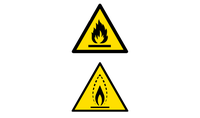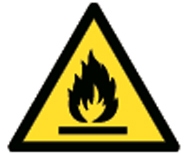Copeland supplies components (e.g., compressors, condensers, drives) for air conditioning and refrigeration systems designed and manufactured by Original Equipment Manufacturers (OEMs). Always consult the OEM’s warnings and instructions when servicing a system, as well as any warnings and instructions provided by Copeland for components involved in the service task.
Even if you don’t plan to work on systems with flammable refrigerants, you should be aware of some basic information about them in case you encounter such a system in the field.

What are flammable refrigerants?
“Flammable refrigerants" refer to both flammable and mildly flammable refrigerants. The American Society of Heating, Refrigerating, and Air-Conditioning Engineers (ASHRAE) standard 34 classifies refrigerants based on their toxicity and flammability. Refrigerants are assigned to one of two toxicity classifications: A (refrigerants with an occupational exposure limit of 400 ppm or greater) or B (refrigerants with an occupational exposure limit of less than 400 ppm). Refrigerants are assigned to one of four flammability classifications (1, 2L, 2, 3) with flammable refrigerants classified as 2L, 2, or 3. These toxicity and flammability characters combine to form a refrigerant safety classification (e.g., “A2L” or “B1”). Common examples of flammable refrigerants include R-290 (Class A3), R-152a (Class A2), and R-32 (Class A2L). As used herein, “flammable refrigerants” refers to any refrigerants classified as 2L, 2 or 3.
Even if you don’t plan to work on systems with flammable refrigerants, you should be aware of some basic information about them in case you encounter such a system in the field.
Copeland uses or may use in the future, the flammable refrigerant types set forth here.
 | YOU MUST HAVE SPECIALIZED TRAINING BEFORE SERVICING SYSTEMS CONTAINING FLAMMABLE REFRIGERANTS EPA certification is not enough. Servicing HVAC/R systems with flammable refrigerants requires additional certification. One such flammable refrigerant certification is the Hydrocarbon Training Program offered by the Refrigeration Service Engineers Society (RSES). (See below for more information.) If you have not received certification for completing the Hydrocarbon Training Program and passed the examination, or received equivalent training and certification, do not service any system containing flammable refrigerants. |
 | FLAMMABLE REFRIGERANT CAN IGNITE OR EXPLODE. If flammable refrigerant is released from a system, an explosive concentration can be present in the air near the system. If there is an ignition source nearby, a release of flammable refrigerant can result in a fire or explosion. While systems using flammable refrigerant are designed to mitigate the risk of ignition by the system if the refrigerant is released, fire and explosion can still occur. |
 | ALWAYS USE A COMBUSTIBLE GAS MONITOR WHEN SERVICING SYSTEMS CONTAINING FLAMMABLE REFRIGERANTS. Before and during servicing, always check the area around the system with a combustible gas monitor rated for the specific class of flammable refrigerant (Class 3, 2 or 2L) in the system.[AS1] Keep the monitor on until you can confirm that refrigerant does not reach detectable combustible levels. If combustible levels are detected at any point in the process, then STOP service, ventilate and evacuate the area. Do not perform any further service to the system unless you are specifically trained on flammable refrigerants. |
How do I know if a system uses flammable refrigerants?
One of the first steps in safely working on a system is to identify the refrigerant used in the system and whether it is flammable. There are several ways to check if a system uses flammable refrigerant.
1. Check the system nameplate
The system nameplate indicates the type of refrigerant intended for use in the system. Before servicing, make sure you are familiar with the specified refrigerant and its classification. Safety classifications for refrigerants are found in ASHRAE 34. You can also consult this list of refrigerants and lubricants approved for use with Copeland compressors. (NOTE: Remember Class 3, 2, and 2L refrigerants are flammable).
2. Check for a flame symbol on the system
Systems using flammable refrigerants are required to the bear following symbols:

Safety Symbol for Class 2 and 3 Refrigerants

Safety Symbol for Class A2L refrigerantS
3. Check for red tubing near the compressor
Systems using flammable refrigerants should be colored red at the refrigerant process tubing and service ports or wherever a service technician may puncture the tubing.
If any of these three checks indicates that flammable refrigerants are present, then service techniques specific to flammable refrigerants must be used.
How can I determine which refrigerants a component is compatible with?
A system may contain a number of Copeland components - compressors, drives, refrigeration controls, etc. Visit the Copeland online product information page to access data on Copeland components, including compatible refrigerants.
If you have any questions regarding Copeland products, consult your local Copeland representative.
What tools and equipment are required to work on flammable refrigerant systems?
You should have the following tools and equipment to service a system with flammable refrigerants:
- Combustible gas monitor
- Appropriate personal protective equipment such as safety goggles and gloves
- Safety Placard (Indicating flammable gases may be present)
- Class B Fire Extinguisher
- Ventilating fan
- Recovery equipment – Vacuum pump, tank, manifold gauge set – rated for flammable refrigerants
- Dry Nitrogen to Purge System Lines
- Pinch Off or Tubing Cutter Tool
- Crimper and crimper valves
- Appropriate replacement refrigerant for the system being serviced
- Liquid soap to check for leaks
If you do not have these items with you, do not service any system containing flammable refrigerants.
What are some safety procedures to know when working with flammable refrigerants?
Working with flammable refrigerants requires special precautions. You should learn these through specific training on flammable refrigerants. As always, you should also follow all warnings and instructions from the system manufacturer, as well as from the manufacturer of any component involved in the service task.
Examples of the types of precautions to take when working with flammable refrigerants include:
- Never disconnect power, unplug anything, or begin servicing a system before checking the area for the presence of flammable refrigerants or other flammable substances with a combustible gas monitor designed for use with flammable refrigerants and that meets the manufacturer recommendations.
- After the absence of flammable refrigerants has been confirmed, the system should be de-energized before any further servicing is conducted.
- Service technicians must: Monitor–Ventilate–Eliminate
- Monitor the area for combustible gases.
- Ventilate the area to get rid of any combustible gases.
- Eliminate any sources of ignition.
- If flammable refrigerants are purged from the system, use recovery equipment designed for use with flammable refrigerants. Use an inert gas such as dry nitrogen or something similar when purging the system. If controlled venting of flammable refrigerants is permitted, venting should take place in a well-ventilated area, far from all sources of ignition. Maintain at least a 10-foot radius around the compressor free of sources of ignition, people, and anything that can burn. The work area should be designated and sectioned off, and any others working in the vicinity should be alerted to the possible presence of flammable substances. Leave the combustible gas monitor on until it no longer detects flammable gases or vapors.
- Never use a torch to remove compressor components or tubing. Always use tubing cutters.
- Always use approved components when replacing parts.
- Before finalizing service, make sure that all wires are correctly and tightly connected. Improper connections may cause fire or electric shock, or explosion in systems containing flammable refrigerants.
How can I learn more about flammable refrigerants?
| there are a number of resources available to learn more about flammable refrigerants | |
|---|---|
 |
RSES study guide The Refrigeration Service Engineers Society (RSES) offers a digital certificate to HVACR technicians working on flammable refrigerant systems who complete and pass the examination as part of the Hydrocarbon Training Program. In order to pass this examination, technicians must study the “Hydrocarbon Refrigerants: A Study Guide for Service Technicians”. This document also provides training on HFO and HFO blend refrigerants.
|
 |
Copeland Copeland offers self-paced and instructor-led HVACR training courses. Either sign in or register to find out what courses are offered. Some classes cover topics related to flammable refrigerants. These classes are intended as a supplement to, not a replacement for, certified flammable refrigerant training
|
 |
Mainstream Engineering Additionally, HVACR personnel can obtain a HC/HFO certification through Mainstream Engineering at the EPAtest.com portal. The HC/HFO certification and accompanying study guide covers the techniques and regulations for the safe handling of flammable hydrocarbon and hydrofluoroolefin refrigerants. This certification is not sufficient for proper flammable refrigerant training but remains a good resource to learn more on the topic.
|
|
Refrigeration and Air Conditioning System OEM Training and Information
|
Reference materials
1. Refrigeration & Air Conditioning Technology - Unit 9, sections 9.8 and 9.9
An HVACR textbook that covers the details of working with HFO (section 9.8) and HC (section 9.9) refrigerants, including the different types of installations and applications.
2. Evolving Safety Standards for A2L and A3 Refrigerants
Covers the governing standards on flammable refrigerants, as well as the criteria evaluated to determine the safety of a flammable refrigerant.
3. New Refrigerants Designation and Safety Classifications
Presentation by Copeland on the overview of regulations driving refrigerant changes, description of the class 2L “mildly flammable” refrigerant, and basic servicing instructions for flammable refrigerants.
4.Safety Instructions for Copeland Brand Compressors
A general list of safety statements and warnings regarding the installation, commission, and maintenance of compressor equipment.
Please continue to check back for the latest safety information. Content is being updated regularly.

